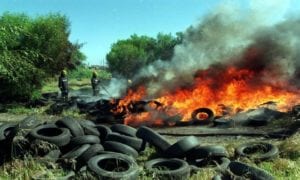Waste tyres are most hazardous when they are burnt in uncontrolled environments. This is according to the National Policy on High Temperature Thermal Waste Treatment and Cement Kiln for Alternative Fuel Use.
Waste tyres are typically burnt in South Africa for the scrap metal content, and in the winter months for warmth, but health authorities have now warned that the inhalation of smoke from burning tyres in the open can cause lung and respiratory infections and worsen asthma, possibly leading to heart disease and the eventuality of death. The Ministry of Environment Wildlife and Tourism in Botswana, says burning tyres in the open releases substances and gases including sulphur compounds, hydrocarbons, and oxides of carbon and nitrogen that are toxic to people and the environment. Extinguishing the fire with water may enhance leaching of the oil – leading to soil and water contamination.The Recycling and Economic Development Initiative of South Africa (REDISA) agrees and points out that some of the chemicals released into the air include polycyclic aromatic hydrocarbons (PAHs), benzene, styrene, phenols, and butadiene.
“Oil that exudes into ground and surface water as a result of tyre fires is a significant environment pollutant. For every million tyres consumed by fire, about 55 000 tonnes of runoff oil can pollute the environment unless contained and collected,” adds Stacey Davidson, director at REDISA.Davidson says the significant problems that waste tyres cause to the environment cannot be underestimated. She notes that REDISA is making headway cleaning the environment of waste tyres and as at end of September 2014; the organisation has potentially offset 103 379.55 tonnes of carbon emissions. (This is assuming that the tyres collected, would have otherwise been burned.)








